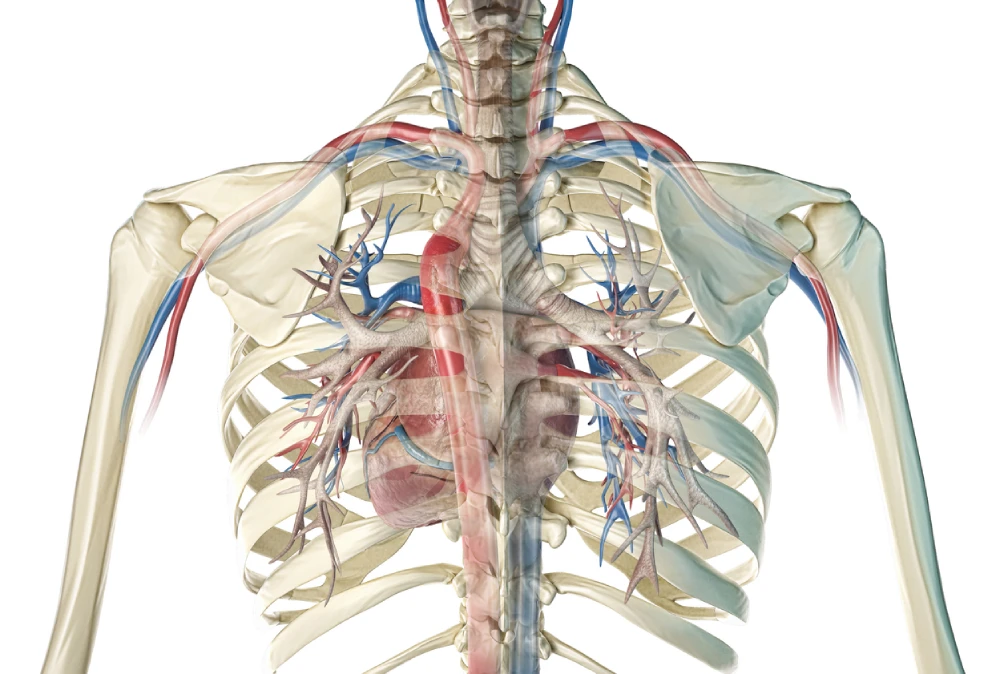
Living with thoracic outlet syndrome (TOS) can feel overwhelming and isolating. The persistent pain, numbness, and weakness in your arms and hands may have disrupted your daily activities, work performance, and quality of life. If you’re reading this, you’re likely searching for answers and hope for effective treatment. As a thoracic surgeon, I understand the profound impact this condition can have on your life, and I want you to know that there are proven treatment options available to help you reclaim your comfort and functionality.
What is Thoracic Outlet Syndrome?
Thoracic outlet syndrome is a complex condition that occurs when blood vessels or nerves (neurovascular structures) in the thoracic outlet—the narrow space between your collarbone and first rib—become compressed or irritated. This compression can cause a constellation of symptoms that significantly impact your daily life, from simple tasks like typing at a computer to more demanding activities like lifting objects or playing sports.
The thoracic outlet serves as a crucial passageway for important structures traveling from your neck to your arm, including the brachial plexus (a network of nerves), subclavian artery and vein, and surrounding muscles. When this space becomes narrowed due to various factors, the resulting compression can lead to the debilitating symptoms characteristic of TOS.
Understanding your condition is the first step towards an effective treatment option. Many patients feel frustrated by the complexity of their symptoms and the time it takes to receive an accurate diagnosis. Rest assured that with proper evaluation and treatment from an experienced specialist, most patients can achieve significant symptom relief and return to their normal activities.
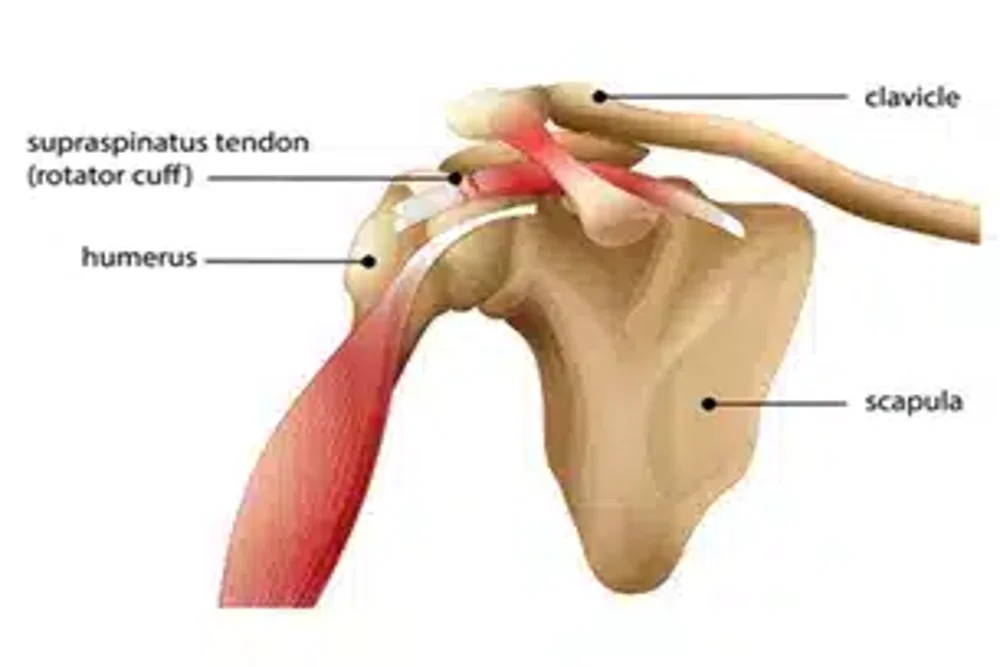
Types of Thoracic Outlet Syndrome
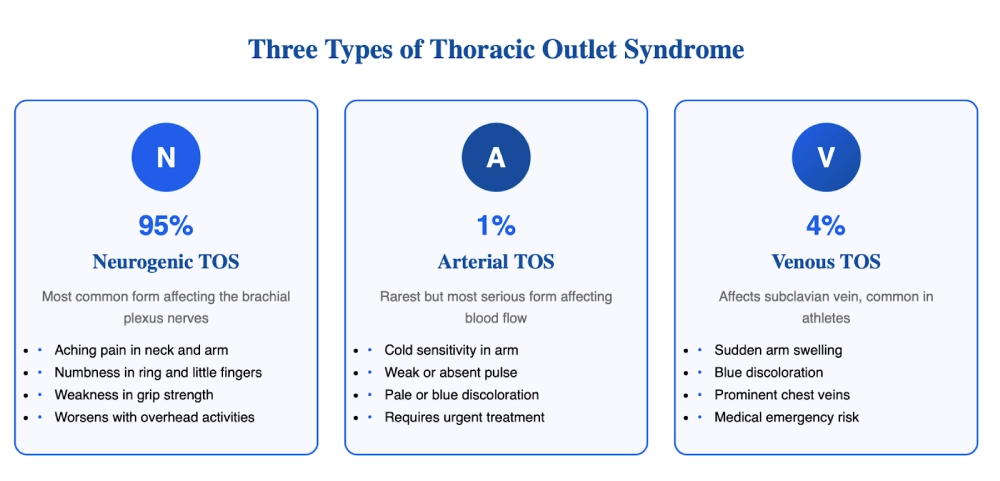
Thoracic outlet syndrome manifests in three distinct forms, each requiring a tailored approach to treatment:
Neurogenic Thoracic Outlet Syndrome (nTOS)
Neurogenic TOS is the most common form, accounting for approximately 95% of all cases. This type occurs when the brachial plexus nerves become compressed, typically between the anterior and middle scalene muscles or at the level of the first rib. Patients with neurogenic TOS often experience:
- Aching pain in the neck, shoulder, and arm
- Numbness and tingling in the fingers, particularly the ring and little fingers
- Weakness in grip strength
- Muscle wasting in the hand (in severe, long-standing cases)
- Symptoms that worsen with overhead arm activities
The pain associated with neurogenic TOS can be particularly distressing because it often occurs during routine activities. Many patients describe feeling helpless when simple tasks, such as reaching for items on a shelf or sleeping in certain positions, become sources of significant discomfort.
Arterial Thoracic Outlet Syndrome (aTOS)
Arterial TOS is the rarest but most serious form of the condition, occurring when the subclavian artery becomes compressed. This type often results from anatomical abnormalities such as cervical ribs or abnormal first ribs. Symptoms of arterial TOS include:
- Cold sensitivity in the affected arm and hand
- Numbness and tingling in the fingers
- Arm fatigue with minimal exertion
- Weak or absent pulse in the affected arm
- Pale or bluish discoloration of the hand
- In severe cases, blood clots or aneurysms may develop
Arterial TOS requires urgent medical attention from a qualified thoracic surgeon, as delayed treatment can lead to serious complications, including limb-threatening ischemia.
Venous Thoracic Outlet Syndrome (vTOS)
Venous TOS, also known as Paget-Schroetter syndrome or “effort thrombosis,” occurs when the subclavian vein becomes compressed, often leading to blood clot formation. This type typically affects young, athletic individuals who perform repetitive overhead activities. Symptoms include:
- Sudden onset of arm swelling
- Blue or dark discoloration of the arm
- Prominent veins across the chest and shoulder
- Aching pain in the shoulder and arm
- Heaviness or fatigue in the affected arm
Venous TOS constitutes a medical emergency requiring immediate thoracic outlet syndrome treatment to prevent potentially life-threatening complications such as pulmonary embolism.
Recognising the Symptoms
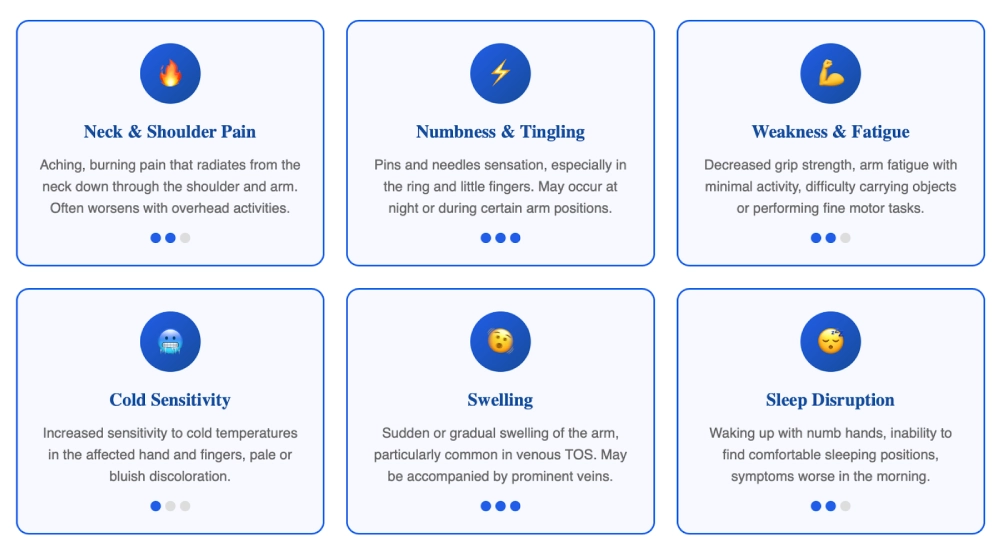
The symptoms of thoracic outlet syndrome can vary significantly between individuals and may develop gradually over time or appear suddenly following an injury or change in activity level. Understanding these symptoms can help you communicate more effectively with your healthcare provider and advocate for appropriate treatment.
Early Warning Signs
Many patients initially dismiss early TOS symptoms as temporary discomfort from poor posture or overuse. However, recognising these early signs can lead to earlier intervention and better outcomes:
- Intermittent numbness or tingling in the arms or hands, particularly at night
- Occasional sharp or shooting pains from the neck down the arm
- Fatigue in the arms during activities that weren’t previously challenging
- Sensitivity to cold in the hands and fingers
- Subtle changes in grip strength or dexterity
Progressive Symptoms
As the condition advances, symptoms typically become more persistent and severe:
- Constant aching or burning pain in the neck, shoulder, and arm
- Frequent numbness and tingling that interferes with daily activities
- Noticeable weakness in the affected arm
- Difficulty performing overhead activities
- Sleep disruption due to pain and numbness
- Changes in skin color or temperature in the affected hand
Impact on Daily Life
The progression of TOS symptoms can significantly impact various aspects of your life. Many patients describe feeling frustrated and anxious as their condition affects their ability to work effectively, participate in recreational activities, and maintain their independence in daily tasks. The invisible nature of nerve pain can also lead to feelings of isolation and misunderstanding from family members, friends, and colleagues who may not fully comprehend the extent of your discomfort.
Understanding that these feelings are normal and that effective treatment options are available can provide hope and motivation as you work towards recovery with your thoracic outlet syndrome surgeon.
Causes and Risk Factors
Thoracic outlet syndrome can develop due to various anatomical, traumatic, or repetitive stress factors. Understanding these causes can help in both prevention and treatment planning.
Anatomical Abnormalities
Some individuals are born with anatomical variations that predispose them to developing TOS:
- Cervical ribs: Extra ribs arising from the seventh cervical vertebra, present in approximately 1% of the population
- Abnormal first ribs: Ribs with unusual shapes or attachments that narrow the thoracic outlet
- Fibrous bands: Tight connective tissue bands connecting the cervical spine to the first rib
- Muscle variations: Unusual insertion points or sizes of the scalene muscles
Traumatic Causes
Trauma to the neck and shoulder region can trigger the development of TOS by causing inflammation, muscle spasm, or scar tissue formation:
- Motor vehicle accidents: Whiplash injuries commonly lead to muscle imbalances and trigger point development
- Sports injuries: Contact sports or activities involving overhead motions can cause acute trauma
- Falls: Direct impact to the shoulder or neck region
- Repetitive microtrauma: Cumulative stress from occupational or recreational activities
Occupational and Lifestyle Risk Factors
Certain occupations and lifestyle factors increase the risk of developing TOS:
- Computer work: Prolonged poor posture and forward head positioning
- Overhead activities: Athletes, painters, electricians, and others who perform repetitive overhead motions
- Heavy lifting: Jobs requiring frequent lifting of heavy objects
- Musicians: Particularly string and wind instrument players who maintain prolonged static postures
- Poor ergonomics: Inadequate workplace setup leading to muscle imbalances and postural dysfunction
Additional Contributing Factors
Several other factors can contribute to the development or exacerbation of TOS:
- Pregnancy: Hormonal changes and postural adaptations during pregnancy
- Weight gain: Increased tissue mass in the neck and shoulder region
- Age-related changes: Degenerative changes in the spine and surrounding structures
- Systemic conditions: Conditions affecting connective tissue or causing inflammation
Diagnostic Approach
Accurate diagnosis of thoracic outlet syndrome requires a comprehensive evaluation by an experienced thoracic outlet syndrome specialist. The diagnostic process can be challenging because TOS symptoms can mimic other conditions, and there is no single definitive test for the condition.
Clinical History and Physical Examination
Your journey towards diagnosis begins with a detailed discussion of your symptoms, medical history, and lifestyle factors. During this consultation, your surgeon will explore:
- The onset, duration, and progression of your symptoms
- Specific activities or positions that trigger or worsen your symptoms
- Previous injuries or surgeries to the neck, shoulder, or arm
- Your occupational and recreational activities
- Previous treatments you’ve tried and their effectiveness
The physical examination includes several specialised tests designed to reproduce your symptoms and assess the function of nerves and blood vessels in the thoracic outlet region:
- Adson’s test: Assesses for arterial compression with neck rotation and deep inspiration
- Wright’s test: Evaluates symptoms with arm abduction and external rotation
- Roos test: Tests for neurogenic symptoms with prolonged arm elevation
- Costoclavicular maneuver: Assesses compression between the clavicle and first rib
- Neurological assessment: Evaluates sensation, strength, and reflexes in the affected arm
Imaging Studies
While no single imaging study can definitively diagnose TOS, several tests can provide valuable information:
- X-rays: Can identify cervical ribs, abnormal first ribs, or other bony abnormalities
- MRI: Excellent for visualising soft tissue structures, nerve compression, and ruling out other conditions
- CT angiography: Provides detailed images of blood vessels and can identify vascular compression
- Ultrasound: Can assess blood flow and detect vascular abnormalities during positional testing
Specialised Testing
Additional tests may be recommended based on your specific symptoms:
- Nerve conduction study: Can help identify nerve compression, though normal results don’t rule out TOS
- Electromyography (EMG): Assesses muscle function and can detect signs of nerve damage
- Vascular studies: Doppler ultrasound or angiography to evaluate blood flow
Differential Diagnosis
An experienced thoracic surgeon will also consider other conditions that can mimic TOS symptoms:
- Cervical disc herniation or spinal stenosis
- Carpal tunnel syndrome
- Ulnar neuropathy at the elbow
- Rotator cuff injuries
- Fibromyalgia
- Complex regional pain syndrome
Conservative Treatment Options
The majority of patients with thoracic outlet syndrome can achieve significant symptom relief through conservative, non-surgical treatment approaches. These treatments are typically the first line of therapy and may be sufficient for long-term management of your condition.
Physical Therapy
Physical therapy forms the cornerstone of conservative TOS treatment. A skilled physical therapist will develop a personalised program addressing your specific symptoms and functional limitations:
Postural Correction: Poor posture is often both a cause and consequence of TOS. Your therapy will focus on:
- Strengthening weak muscles, particularly the deep neck flexors and lower trapezius
- Stretching tight muscles, including the scalenes, pectorals, and upper trapezius
- Education about proper workplace ergonomics and daily positioning
- Development of body awareness to maintain improved posture throughout the day
Range of Motion Exercises: Maintaining and improving flexibility in the neck, shoulder, and thoracic spine is crucial for reducing compression in the thoracic outlet:
- Gentle neck stretches and rotations
- Shoulder blade mobilisation exercises
- Thoracic spine extension and rotation activities
- Progressive stretching of restricted soft tissues
Strengthening Program: Building strength in key muscle groups helps maintain proper positioning and reduce strain on compressed structures:
- Deep neck stabiliser strengthening
- Scapular stabilisation exercises
- Rotator cuff strengthening
- Core stability training to support improved posture
Manual Therapy: Hands-on techniques can provide immediate symptom relief and improve tissue mobility:
- Soft tissue mobilisation to address muscle tension and trigger points
- Joint mobilisation to improve movement in restricted segments
- Myofascial release techniques
- Nerve mobilisation exercises to improve neural tissue flexibility
Activity Modification
Learning to modify activities that aggravate your symptoms is essential for symptom management and healing:
- Workplace adjustments: Optimising your workstation setup, taking frequent breaks, and alternating between tasks
- Sleep positioning: Using supportive pillows and avoiding positions that compress the thoracic outlet
- Exercise modifications: Adapting recreational activities to avoid symptom provocation
- Daily living adaptations: Techniques for performing routine tasks with less stress on the affected area
Medication Management
While medications alone rarely cure TOS, they can provide valuable symptom relief during the healing process:
- Anti-inflammatory medications: Non-steroidal anti-inflammatory drugs (NSAIDs) can help reduce inflammation and pain, though they should be used judiciously and under medical supervision.
- Neuropathic pain medications: For patients with significant nerve-related symptoms, medications such as gabapentin or pregabalin may provide relief.
- Muscle relaxants: The short-term use of muscle relaxants may help reduce muscle spasms and tension.
- Topical medications: Topical anti-inflammatory or analgesic preparations can provide localised relief without systemic side effects.
Injection Therapy
Targeted injection therapy can provide significant symptom relief and diagnostic information:
- Trigger point injections: Direct injection of local anesthetic into trigger points in the scalene muscles can provide both diagnostic and therapeutic benefits.
- Nerve blocks: Scalene muscle or brachial plexus blocks can help confirm the diagnosis and provide temporary symptom relief.
- Botulinum toxin injections: In select cases, botulinum toxin injections into the scalene muscles can provide longer-lasting muscle relaxation.
Stress Management and Lifestyle Modifications
The chronic nature of TOS symptoms can create a cycle of stress and tension that worsens the condition. Addressing these psychological and lifestyle factors is crucial for comprehensive treatment:
- Stress reduction techniques: Meditation, deep breathing exercises, and progressive muscle relaxation
- Sleep hygiene: Establishing consistent sleep patterns and creating an optimal sleep environment
- Nutritional support: Maintaining a healthy diet to support tissue healing and reduce inflammation
- Smoking cessation: Tobacco use impairs circulation and tissue healing
Surgical Treatment Options

When conservative treatment fails to provide adequate symptom relief after 3-6 months of consistent therapy, surgical intervention may be recommended. As a thoracic outlet syndrome surgeon, I understand that the decision to proceed with surgery can feel overwhelming. However, for appropriately selected patients, surgical treatment can provide excellent long-term outcomes and dramatic improvement in quality of life. There are several surgical options, and I will discuss them below.
Indications for Decompression Surgery
Surgery is typically recommended when:
- Conservative treatment has been unsuccessful after 3-6 months
- Symptoms significantly impact daily activities and quality of life
- Progressive neurological deficits are present
- Vascular complications have developed
- Anatomical abnormalities are present that are unlikely to respond to conservative treatment
First Rib Resection
First rib resection is the most common surgical procedure for TOS and can be performed through several approaches:
Transaxillary Approach: This minimally invasive technique involves making a small incision in the armpit area:
- Excellent visualisation of the first rib and surrounding structures
- Minimal scarring and faster recovery
- Lower risk of injury to important nerves and blood vessels
- Suitable for most patients with neurogenic TOS
Supraclavicular Approach: This approach involves an incision above the collarbone:
- Better access for nerve decompression and neurolysis
- Allows for simultaneous treatment of cervical ribs
- May be preferred for patients with significant nerve scarring
- Provides excellent exposure for vascular reconstruction if needed
Infraclavicular Approach: Rarely used as a primary approach, but may be necessary in specific situations:
- Useful for accessing vascular structures
- May be combined with other approaches for complex cases
Cervical Rib Resection
When a cervical rib is present and contributing to symptoms, surgical removal is often necessary. This procedure is typically performed through a supraclavicular approach and may be combined with first rib resection for optimal decompression.
Scalene Muscle Surgery
Scalenectomy (removal of scalene muscles) or scalenotomy (division of scalene muscles) may be performed alone or in combination with rib resection:
- Addresses muscle-related compression
- Can be performed as a less invasive initial procedure
- It may be sufficient for patients with mild anatomical abnormalities
- Lower operative risk compared to rib resection
Vascular Reconstruction
Patients with arterial or venous TOS may require additional vascular procedures, which are performed by a specialist in vascular surgery:
- Arterial reconstruction: May involve bypass grafting, patch angioplasty, or direct repair depending on the extent of arterial damage.
- Venous reconstruction: Can include balloon angioplasty, stenting, or surgical bypass of damaged venous segments.
- Thrombolysis: For acute venous thrombosis, catheter-directed thrombolysis may be performed before surgical decompression.
The Surgical Experience
Understanding what to expect during your surgical journey can help alleviate anxiety and prepare you for a successful outcome.
Pre-operative Preparation
Your preparation for thoracic outlet syndrome surgery begins weeks before your procedure:
- Medical optimisation: Your overall health will be evaluated, and any underlying conditions will be optimised to reduce surgical risk.
- Pre-operative education: You’ll receive detailed information about your procedure, expected outcomes, and post-operative care requirements.
- Anaesthesia consultation: You’ll meet with the anaesthesiologist to discuss anaesthesia options and address any concerns.
- Surgical planning: Advanced imaging studies may be reviewed to finalise the surgical approach and plan.
The Surgical Procedure
Most TOS surgeries are performed under general anaesthesia and typically take 1-3 hours depending on the complexity of the case:
- Positioning: You’ll be positioned to optimise access to the surgical site while protecting all pressure points
- Incision: The incision will be made according to the planned surgical approach
- Decompression: The compressed structures will be carefully identified and decompressed
- Reconstruction: Any necessary vascular reconstruction will be performed
- Closure: The incision will be closed in layers with attention to the cosmetic outcome
Immediate Post-operative Care
Following surgery, you’ll be monitored in the recovery area:
- Pain management with appropriate medications
- Monitoring of arm circulation and neurological function
- Gradual mobilisation as tolerated
- Most patients can go home the same day or after an overnight stay
Recovery and Rehabilitation
Recovery from thoracic outlet syndrome surgery requires patience, dedication, and adherence to your rehabilitation program. Understanding the recovery process can help you maintain realistic expectations and stay motivated during your healing journey.
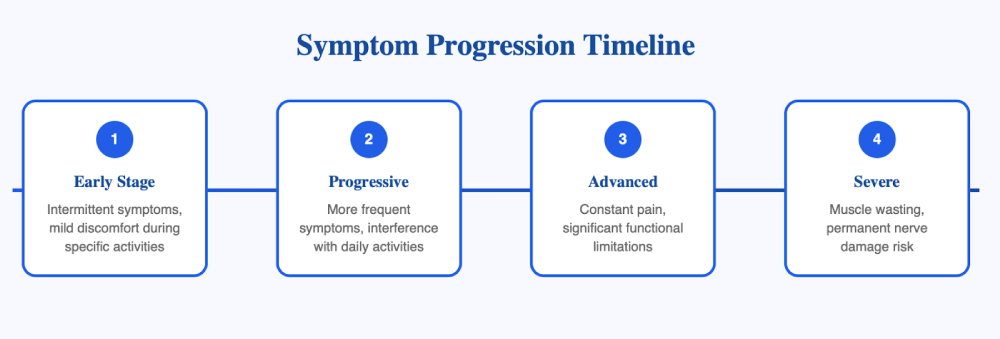
Early Recovery Phase (0-2 weeks)
The initial recovery period focuses on wound healing and pain management:
Pain management: You’ll receive a comprehensive pain management plan that may include:
- Prescription pain medications for the first few days
- Anti-inflammatory medications to reduce swelling
- Ice therapy for localised pain relief
- Gentle positioning techniques to minimise discomfort
Wound care: Proper incision care is crucial for optimal healing:
- Keeping the incision clean and dry
- Following specific dressing change instructions
- Monitoring for signs of infection
- Avoiding submersion in water until cleared by your surgeon
Activity restrictions: Initial limitations help protect the healing tissues:
- Avoiding lifting more than 5-10 pounds
- Limiting overhead arm activities
- No driving while taking prescription pain medications
- Gentle range of motion exercises as directed
Intermediate Recovery Phase (2-6 weeks)
As initial healing progresses, you’ll gradually increase your activity level:
Physical therapy initiation: Most patients begin formal physical therapy 1-2 weeks after surgery:
- Gentle range of motion exercises to prevent stiffness
- Progressive strengthening of surrounding muscles
- Scar tissue mobilisation techniques
- Gradual return to functional activities
Work considerations: Return to work depends on your occupation:
- Desk workers may return in 1-2 weeks with modifications
- Manual laborers may require 6-8 weeks or longer
- Modifications such as ergonomic adjustments may be necessary
- Communication with your employer about limitations is important
Activity progression: Gradual increase in daily activities:
- Lifting restrictions slowly increase to 15-20 pounds
- Driving may resume when you’re no longer taking pain medications
- Light recreational activities may be permitted
- Overhead activities remain restricted
Late Recovery Phase (6 weeks – 6 months)
This phase focuses on returning to full function and preventing recurrence:
Advanced rehabilitation: Physical therapy becomes more intensive:
- Progressive strengthening programs
- Sport-specific or work-specific training
- Postural re-education and ergonomic training
- Long-term maintenance exercise programs
Return to full activity: Most patients can gradually return to full activities:
- Lifting restrictions is progressively removed
- Sports and recreational activities can be resumed
- Work duties can typically be performed without restrictions
- Overhead activities are gradually reintroduced
Long-term monitoring: Regular follow-up visits ensure optimal outcomes:
- Assessment of symptom resolution
- Monitoring for any complications
- Adjustment of activity levels as needed
- Long-term prevention strategies
Expected Outcomes and Success Rates
Understanding realistic expectations for your thoracic outlet syndrome treatment can help you make informed decisions and maintain appropriate hope throughout your recovery journey.
Conservative Treatment Outcomes
Conservative treatment can be highly effective when properly implemented:
- 50-80% of patients experience significant symptom improvement with comprehensive conservative treatment
- Best results are seen in patients with mild to moderate symptoms and good compliance with therapy
- Earlier intervention typically leads to better outcomes
- Some patients may require periodic “tune-up” therapy sessions for maintenance
Surgical Outcomes
When performed by an experienced thoracic outlet syndrome surgeon, surgical treatment provides excellent results:
Overall success rates:
- 85-95% of patients experience good to excellent results
- Neurogenic TOS typically has the best surgical outcomes
- Arterial and venous TOS may require additional procedures, but generally have good outcomes
- Patient satisfaction rates are typically very high
Symptom resolution:
- Pain relief is often dramatic and immediate in many patients
- Numbness and tingling may take several months to fully resolve
- Strength typically returns gradually over 3-6 months
- Most patients can return to their previous activity level
Factors affecting outcomes:
- Earlier surgical intervention generally leads to better results
- Patients with isolated neurogenic TOS tend to have better outcomes
- Compliance with post-operative rehabilitation is crucial
- Pre-existing nerve damage may limit recovery potential
Long-term Prognosis
With appropriate treatment, most patients with TOS can expect:
- Significant long-term symptom relief
- Return to previous work and recreational activities
- Low recurrence rates when proper preventive measures are followed
- Improved overall quality of life and functional capacity
Prevention and Long-term Management
Once you’ve achieved symptom relief through treatment, maintaining your improvement and preventing recurrence becomes the focus of your long-term care plan.
Ergonomic Considerations
Proper workplace and home ergonomics are crucial for preventing TOS recurrence:
Workstation setup:
- Monitor at eye level to prevent forward head posture
- Keyboard and mouse at an appropriate height
- Supportive chair with good lumbar support
- Frequent position changes and breaks
Daily activities:
- Proper lifting techniques using legs rather than the back
- Avoiding prolonged overhead activities
- Maintaining good posture during daily tasks
- Using supportive pillows for sleep positioning
Exercise and Fitness
A long-term exercise program is essential for maintaining your recovery:
- Strengthening exercises: Focus on maintaining strength in the muscles that support proper posture and shoulder blade position.
- Flexibility maintenance: Regular stretching helps prevent the return of muscle tightness and restrictions.
- Cardiovascular fitness: General fitness supports overall health and can help prevent the development of other conditions.
- Activity modification: Learning to modify activities that may stress the thoracic outlet region.
Lifestyle Modifications
Several lifestyle factors can help maintain your recovery:
- Stress management techniques to prevent muscle tension
- Maintaining a healthy weight to reduce strain on supporting structures
- Smoking cessation to optimise circulation and healing
- Regular medical check-ups to monitor your condition
Warning Signs
Knowing when to seek additional treatment is important for preventing recurrence:
- Return of numbness, tingling, or pain
- Changes in arm strength or function
- New symptoms or worsening of previous symptoms
- Difficulty performing activities that were previously comfortable
The Importance of Specialised Care
Thoracic outlet syndrome is a complex condition that requires specialised knowledge and experience for optimal treatment. Working with a specialist experienced in thoracic outlet syndrome ensures you receive the most current and effective treatment approaches available.
Why Specialisation Matters
TOS treatment requires:
- Deep understanding of the complex anatomy involved
- Experience with various surgical approaches and their indications
- Knowledge of potential complications and how to avoid them
- Familiarity with the latest research and treatment developments
Comprehensive Care Team
The best outcomes are achieved through a team approach that may include:
- Experienced thoracic surgeons
- Specialised physical therapists
- Pain management specialists
- Occupational therapists
- Vascular surgeons, when needed
Your Journey Forward

Living with thoracic outlet syndrome can be challenging, but you don’t have to face this journey alone. With proper diagnosis, appropriate treatment, and ongoing support, most patients can achieve significant symptom relief and return to their normal activities.
Taking the First Step
If you’re experiencing symptoms of thoracic outlet syndrome, the first step is scheduling a consultation with a qualified thoracic outlet syndrome specialist. During this initial visit, you can:
- Receive a comprehensive evaluation of your symptoms
- Discuss your treatment options in detail
- Develop a personalised treatment plan
- Address any concerns or questions you may have
Commitment to Recovery
Successful treatment of TOS requires a partnership between you and your healthcare team. Your commitment to following treatment recommendations, attending therapy sessions, and making necessary lifestyle modifications plays a crucial role in your recovery.
Hope for the Future
Advances in our understanding of thoracic outlet syndrome, combined with improvements in surgical techniques, continue to enhance treatment outcomes. Research into new minimally invasive approaches and innovative rehabilitation techniques offers hope for even better results in the future.
Conclusion
Thoracic outlet syndrome is a treatable condition that, while complex, responds well to appropriate care from experienced specialists. Whether your treatment involves conservative management or surgical intervention, the goal remains the same: helping you return to a comfortable, active lifestyle free from the limitations imposed by TOS symptoms.
Remember that every patient’s journey is unique, and what works for one person may not be the best approach for another. This is why working with an experienced specialist who can tailor treatment to your specific needs is important.
If you’re ready to take the next step in addressing your thoracic outlet syndrome, I encourage you to seek consultation with a qualified specialist. With proper treatment and dedication to your recovery, you can look forward to a future free from the pain and limitations of TOS.
Your path to recovery starts with that first step—reaching out for the specialised care you deserve. Don’t let thoracic outlet syndrome continue to control your life when effective treatment options are available to help you reclaim your comfort and functionality.